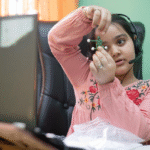Introduction
How Technology Is Transforming Classrooms in the United States
Technology has become an essential part of our everyday lives, and its impact on education in the United States is more visible than ever. From digital whiteboards and online learning platforms to virtual reality and artificial intelligence, the modern classroom is evolving quickly. These tools are not just about convenience—they’re shaping how students learn, how teachers teach, and how schools prepare young minds for the future.
In this article, we’ll explore how technology is transforming U.S. classrooms, the benefits and challenges it brings, and what the future of education might look like in a digitally connected world.
The Digital Shift in Education
In the past, classrooms mostly relied on chalkboards, printed textbooks, and physical assignments. But today, the use of laptops, tablets, and internet-connected devices is becoming the new standard in schools across the country.
This digital shift has been accelerated by the COVID-19 pandemic, which forced schools to adopt remote learning. Now, many schools continue to use online tools even during in-person classes. Technology is no longer a luxury—it’s a necessity in American education.
Key Technologies Changing Classrooms
1. Smartboards and Interactive Displays
Smartboards are replacing traditional blackboards. These touch-sensitive screens allow teachers to write, draw, display videos, and access online content all in one place. Students can also interact with smartboards, making learning more hands-on and engaging.
2. Learning Management Systems (LMS)
Platforms like Google Classroom, Canvas, and Schoology help teachers share lessons, assign homework, track progress, and communicate with students and parents. LMS tools are becoming a backbone of classroom organization and learning.
3. Educational Apps and Games
Apps such as Khan Academy, Quizlet, and Duolingo turn learning into a fun experience. These platforms offer video lessons, flashcards, quizzes, and even gamified activities that make studying more interactive and less stressful.
4. Tablets and Chromebooks
Many schools now provide students with their own digital devices. These tools give students immediate access to the internet, research tools, and educational content. They also reduce the need for heavy backpacks full of books.
5. Virtual Reality (VR) and Augmented Reality (AR)
Although still growing in schools, VR and AR allow students to explore virtual environments—like ancient cities or the solar system—right from their classroom seats. This makes abstract or distant concepts feel real and exciting.
Benefits of Technology in the Classroom
1. Personalized Learning
Every student learns differently. With technology, students can learn at their own pace. Some apps adapt to the student’s skill level and provide extra help where needed, which allows for more personalized education.
2. Improved Engagement
Interactive tools like videos, simulations, and educational games capture students’ attention. Lessons become more dynamic, encouraging active participation rather than passive listening.
3. Better Collaboration
Technology makes it easy for students to work together on projects—whether they’re in the same classroom or different locations. Group chats, shared documents, and video calls are commonly used for collaborative learning.
4. Immediate Feedback
Students can get instant results on quizzes and assignments through digital platforms. This allows them to correct mistakes quickly and learn more effectively.
5. Skill Building for the Future
Learning to use technology early helps students prepare for the modern workforce. Digital skills such as typing, researching online, creating presentations, and understanding data are now essential for most careers.
Challenges of Technology in Education
While the benefits are numerous, there are also important challenges that must be addressed.
1. Digital Divide
Not all students have equal access to devices or reliable internet at home. This gap—known as the digital divide—can lead to unequal learning opportunities, especially in rural or low-income areas.
2. Overreliance on Technology
If used excessively, technology may lead to less face-to-face interaction or reduced physical activity. It’s important to maintain a balance between digital tools and traditional methods like reading books or group discussions.
3. Teacher Training
Not every teacher is comfortable with new technology. Schools must invest in proper training so teachers can use tools effectively and confidently.
4. Distractions
With access to the internet and apps, students may be tempted to visit social media or play games during class time. Schools often use monitoring software or website restrictions to manage this.
How Schools Are Adapting
Many school districts across the U.S. are actively adapting to technological changes. Here’s how:
- One-to-One Device Programs: Providing each student with a school-issued tablet or Chromebook.
- Blended Learning Models: Combining traditional in-person teaching with online assignments and activities.
- Tech Support Teams: Hiring IT staff to manage devices, software, and internet issues.
- Online Safety Policies: Teaching students about digital citizenship, cyberbullying, and responsible internet use.
Parents are also being included through parent portals, where they can monitor their child’s grades, assignments, and attendance.
The Future of Technology in Education
The future classroom may look even more advanced than today’s. Here are some trends on the horizon:
- Artificial Intelligence (AI): AI-powered tutors that guide students based on their learning style.
- Cloud Learning: All content stored and accessed via the cloud, making it easier to learn anytime, anywhere.
- Remote Learning Growth: Online schools and hybrid learning will continue to expand, especially for flexible or specialized education.
- Wearable Tech: Devices like smartwatches or AR glasses may become part of daily lessons.
As technology continues to grow, education will evolve to match the demands of the modern world.
Conclusion
Technology is transforming classrooms across the United States, opening new doors for interactive, personalized, and future-ready learning. While challenges like the digital divide and teacher training remain, the overall impact of educational technology is positive and full of potential.
By embracing innovation and ensuring equal access, schools can better prepare students for success in both academics and life. The classroom of tomorrow is already here—and it’s powered by technology.


